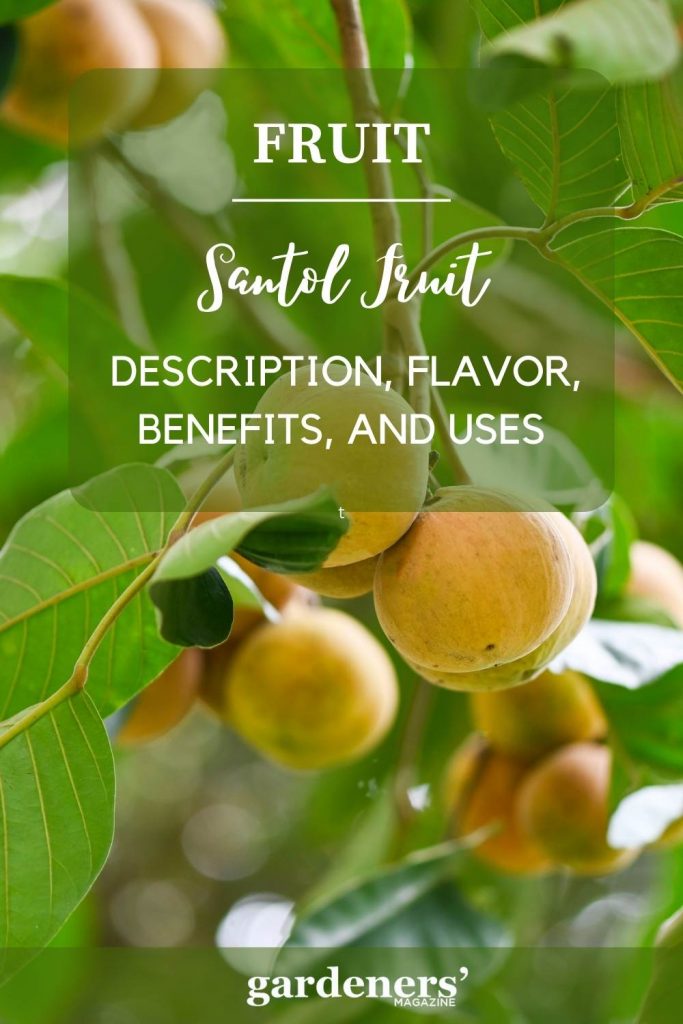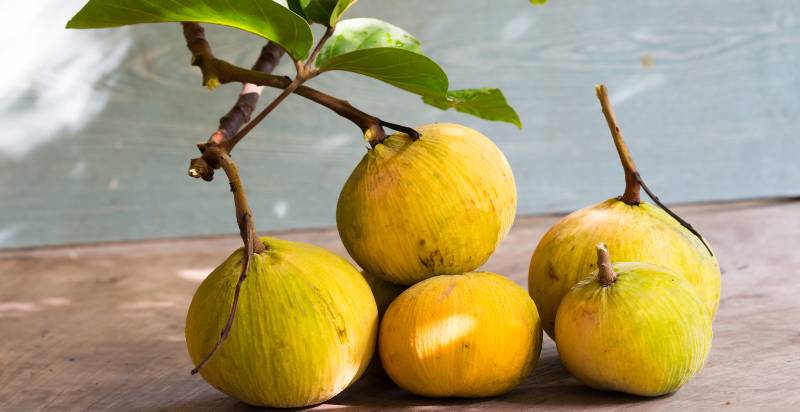Have you ever heard of Santol Fruit? It’s this fascinating tropical fruit that’s not just a treat for your taste buds but also packed with good stuff for your health. Imagine biting into something that’s the perfect mix of sweet and sour, kind of like nature’s own candy, but way better. That’s Santol for you. It’s not just the taste that makes it special; this fruit comes loaded with vitamins and minerals, making it a great addition to a healthy diet. Whether you’re enjoying it fresh out of your hand or mixing it into your favorite dishes, Santol Fruit is a tropical delight that’s definitely worth exploring.
Santol Fruit: An Overview
Santol Fruit, or Sandoricum koetjape as the scientists call it, is one of those tropical treasures that might not be in every fruit bowl, but it sure deserves a spot. Its name comes from the Sanskrit word “sandorika,” meaning “fruit of the earth.” Originating from Southeast Asia, this fruit has made its way across the globe, thanks to its unique flavor and appealing look.
It’s a fruit that’s about the size of a large apple, with a green to yellowish skin that turns a bit golden when it’s ripe and ready to eat. Crack it open, and you’ll find a white, juicy pulp that’s divided into segments, each hiding a seed. The taste? It’s a delightful mix of sweet and sour, with a refreshing tang that’s perfect for hot summer days. Some say it reminds them of other tropical fruits, but Santol has a charm all its own. It’s a fruit that’s not just about the taste; it’s about the experience of discovering something new and delicious.

Nutritional Benefits
Diving into the world of Santol Fruit, it’s not just the unique taste that catches your attention; it’s also the bundle of nutritional benefits it brings to the table. This fruit is like a hidden gem in the nutrition department. Packed with vitamins and minerals, Santol is particularly rich in Vitamin C, which is great for boosting your immune system, especially in those times when you feel a cold coming on. It’s also got a good dose of fiber, making it a friend to your digestive system, helping everything run smoothly.
But that’s not all. Santol Fruit is also a low-calorie option for those keeping an eye on their intake, yet it doesn’t skimp on providing energy. Plus, with antioxidants present, it helps in fighting off those pesky free radicals, contributing to overall health and well-being. And for those looking into natural ways to manage their blood sugar levels, Santol might just be a fruit worth considering. So, while it might not be as famous as some other fruits, its health benefits are definitely something to talk about. Adding Santol to your diet is like giving your body a little extra gift of goodness.
Culinary Uses
So, let’s chat about the culinary adventures you can embark on with Santol Fruit. This little fruit has been a game-changer in my kitchen, offering a splash of tropical flair to dishes that crave a bit of sweetness and tang. You might be surprised at how versatile it really is. From refreshing summer salads that benefit from its juicy crunch to vibrant salsas where its unique flavor truly shines, Santol adds a delightful twist.
I’ve even experimented with it in smoothies, where it blends beautifully with other fruits, creating a drink that’s not only tasty but packed with nutrients. And let’s not forget about jams and jellies; cooking down Santol with a bit of sugar brings out its natural sweetness, making for a spread that’s hard to resist on a warm piece of toast.
For those who enjoy diving into the world of traditional dishes, Santol is a star in many Southeast Asian recipes. It’s used in savory soups and stews, where it imparts a depth of flavor that’s both comforting and exotic. The key is to be open to experimenting. Whether you’re a seasoned chef or just love to play around in the kitchen, Santol Fruit offers endless possibilities to explore and enjoy.
I’ve found that tossing Santol into meals and drinks adds a surprising twist. From zesty salads to refreshing drinks, it’s been a hit. Give it a try in your kitchen; you might just discover your new favorite ingredient.
Growing and Harvesting Santol Fruit
Growing Santol trees has been quite the journey, one filled with learning curves and rewarding harvests. These trees love the warmth, thriving in climates that stay on the toastier side, much like their native Southeast Asia. They’re not too picky about soil, but they do appreciate a spot that drains well. Keeping them happy means making sure they get enough water, especially when they’re young and getting established, but not so much that their feet are always wet.
When it comes to harvesting, timing is everything. You want to wait until the fruits are just right, with a slight give to the touch, signaling they’re ripe and ready. Picking them at this stage ensures you get to enjoy the best of their sweet and tangy flavor. And let me tell you, there’s nothing quite like the taste of a Santol fruit you’ve grown and picked yourself. It’s a satisfying end to the growing season and a tasty reward for all your gardening efforts. Whether you’re new to growing Santol or looking to improve your next harvest, remember, a little care goes a long way in bringing those delightful fruits from tree to table.
Santol Fruit in Different Languages
Diving into the world of Santol Fruit, I’ve discovered many names across the globe know it, and that’s part of its charm. In Chinese, it’s called yang mei, while in Vietnamese, folks refer to it as Quả Sơ Ri. Each name reflects the unique cultural backdrop and the special place this fruit holds in different communities. It’s fascinating to see how one fruit can weave through languages, each name offering a glimpse into its significance and popularity far and wide.
Sharing these names isn’t just about words; it’s about connecting with a wider audience who might know and love this fruit under a different name. It’s a nod to the diverse world of gardening and fruit cultivation, reminding us of the shared joys and challenges, no matter where we are. Whether you’re in a bustling market in Vietnam, a serene garden in China, or anywhere else Santol is cherished, knowing its various names bridges gaps and builds a sense of global community among those of us who appreciate the wonders of nature’s bounty.
Comparison with Mangosteen
Exploring Santol Fruit and Mangosteen side by side has been quite the adventure. While both hail from the tropics and boast a unique blend of sweet and tangy flavors, they each have their own distinct taste that sets them apart. Santol, with its refreshing sourness, contrasts nicely with Mangosteen’s sweeter, more delicate profile. Nutrition-wise, both fruits are powerhouses, packed with vitamins and antioxidants, though their specific benefits vary slightly, making them complementary choices for a healthy diet. In the kitchen, Santol’s versatility shines in both savory and sweet dishes, while Mangosteen often stars in desserts and smoothies. Together, they offer a fascinating glimpse into the diverse world of tropical fruits, each bringing its own flair to the table.

Where to Find Santol Fruit
Finding Santol Fruit can be a bit of a treasure hunt, but it’s definitely worth the effort. I’ve had the best luck at local Asian markets, where it sometimes hides among other exotic fruits. Specialty stores focused on tropical produce are another good bet. And don’t overlook online options; there are plenty of websites that deliver fresh, exotic fruits right to your doorstep. When picking Santol, look for fruits that feel firm with a slight give, indicating they’re just ripe. The skin should be smooth, without any blemishes or soft spots. Trust me, once you get your hands on some high-quality Santol, you’ll be in for a real treat. It’s like bringing a piece of the tropics into your home.
Conclusion
I’ve got to say, diving into the world of Santol Fruit has been an eye-opener. Its unique flavors and health perks are something you don’t want to miss. If you’re curious, I encourage you to give it a try. Whether you snag it from a local market or grow it yourself, there’s something special about tasting and benefiting from its goodness. And if you’ve already had the pleasure, I’d love to hear about it. Got any Santol recipes up your sleeve? Tips on how to grow it? Sharing your experiences can help spread the word about this fantastic fruit. Let’s keep the conversation going and help others discover the joys of Santol Fruit. Trust me, it’s a journey worth taking.
Frequently Asked Questions
Does Santol Fruit need specific growing conditions?
Yes, Santol Fruit thrives in tropical climates with plenty of sunlight and well-draining soil. It prefers a bit of humidity and doesn’t tolerate frost well. If you’re in a cooler area, growing Santol might be challenging unless you can provide a protected environment.
How do you eat Santol Fruit?
Santol Fruit can be eaten fresh or used in cooking. To eat it fresh, cut the fruit into quarters and enjoy the juicy pulp around the seeds. Be cautious with the seeds, as they’re not edible. Santol is also great in salads, jams, and even savory dishes.
Can Santol Fruit be grown in containers?
Growing Santol in containers is possible but challenging due to its size. Choose a large, deep container and ensure it has good drainage. Container-grown Santol trees may need more frequent watering and feeding than those planted in the ground.
- Everything You Wanted to Know About Red Tamarillos - June 2, 2025
- A Guide to Tulips: Everything You Need to Know & More… - June 2, 2025
- Guanabana: Description, Flavor, Benefits, And Uses - May 27, 2025

1 thought on “Savor the Santol: Grow, Taste, and Thrive with This Tropical Powerhouse”
Comments are closed.